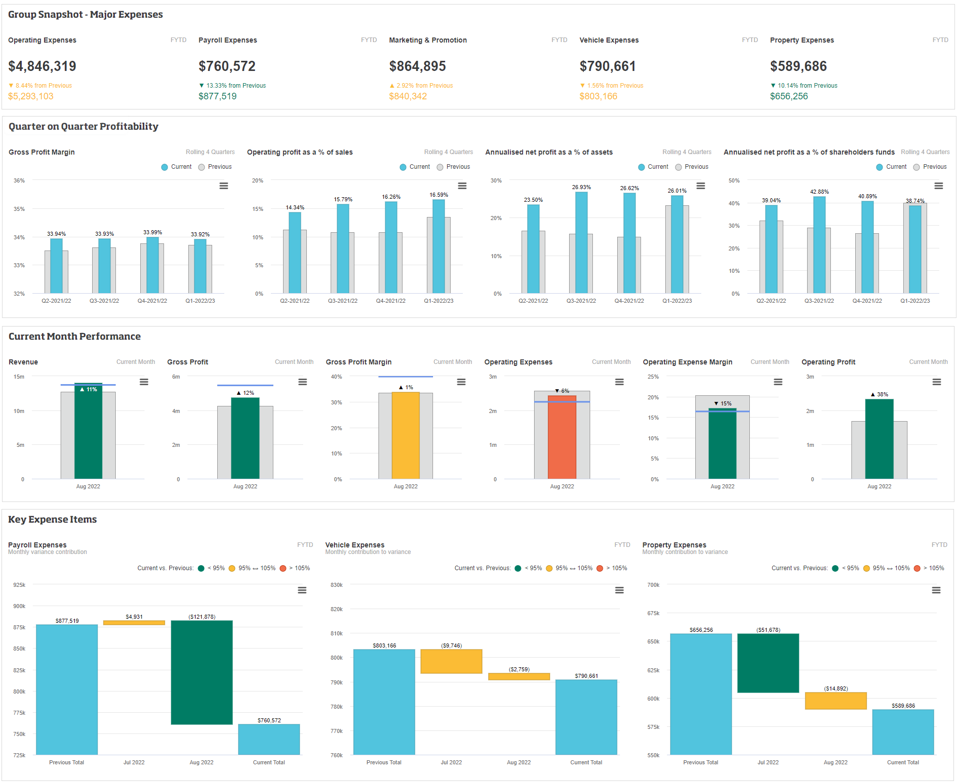Versions Compared
Key
- This line was added.
- This line was removed.
- Formatting was changed.
Dashboards provide powerful insights and overviews of your financial information in one place, making it easy to get quick answers and insights, and monitor performance. Dashboards are made up of lines, in which you can have a range of widgets from different financial statements. For example, you can use different widgets to visualize KPIs and financial ratios that are meaningful to a wide range of audiences. You can also include non-financial metrics to provide context to your financial data and enable a greater understanding.
| Expand | ||
|---|---|---|
| ||
 Image Removed Image Removed |
Learn about what can you add to a dashboard
You can add the following types of content to You can add both grid views and charts, including value cards, as widgets on a dashboard. Displaying the information in different ways often makes it easier to consume.
Grid view - When you change your view of a financial statement to meet your specific needs, you can add that view as a widget on a dashboard. You can also add your favorite views to the dashboard.
In particular, the chart widget is a complex visualization that provides a powerful way to visualize changes and trends in data over time. When you hover over a value in the chart, a tooltip displays
withthe underlying data, including the variance.
Value card - A Value card is a special type of chart, similar to the Summary chart in Analytics. It displays a value for the current period, and the corresponding value from the previous period and/or budget for comparison purposes. It is a useful tool for visualizing your key financial metrics, such as your gross profit margin.| Expand | ||
|---|---|---|
| ||
 Image Added Image Added |
Add a grid view to a dashboard
Change your view of the financial statement grid to display the required information. Alternatively, you can open a favorite view, if applicable.
Click the blue arrow next to the database name and select Add to dashboard.
 Image Removed
Image RemovedSelect one of these options:
Add the widget to an existing dashboard: Select an existing dashboard, and the specific line in that dashboard, in which to display the widget.
Add the widget to a new dashboard: Select the New option from the list, then Select the dashboard on which you want to add the grid widget or select the New option and enter a name for the new dashboard.
Select the line in the dashboard in which you want to display the widget or select the New option and enter a name for the new line. If you are creating a new dashboard, enter a name for the
dashboard andline.
Enter a name for the widget, and a description
, if requiredif required.
Select one of these options:
Click Save if you want to add the widget to the dashboard but continue working with the grid. This option is useful if you want to add other grid view widgets to the dashboard.
Click Save & Open if you want to add the widget to the dashboard and open the dashboard. This option is useful when you are ready to see what the
grid view looks like as a widget on the dashboard.
 Image Added
Image AddedAdd a chart
or Value cardto a dashboard
Create the chart or Value card.
Click the Add to Dashboard… button in the bottom right of the chart panel.
Edit Change the default chart name , if requiredto something more descriptive. By default, the name comes from the selected row(s). This name displays on the widget.
Select the dashboard on which you want to add the chart widget or select New Dashboard and enter a name for that the new dashboard.
Select the line in the dashboard in which you want to display the chart as a widgetthe widget or select the New Line and enter a name for the new line. If you are creating a new dashboard, enter a name for the line.
Select one of these options:
Click Add if you want to add the chart widget to the dashboard and continue working with the grid and chart panelpane. This option is useful if you want to add other chartschart widgets to the dashboard.
Click Add and Open if you want to add the chart widget to the dashboard and open the dashboard. This option is useful when you are ready to see what the chart looks like as a widget on the dashboard.

On this page
| Table of Contents | ||||
|---|---|---|---|---|
|
| Panel | ||
|---|---|---|
| ||
Related pagesDashboards are one of the key features of Phocas and are available across all modules. See the Dashboards section of this help center to learn more. |
| Panel | ||
|---|---|---|
| ||
Video |